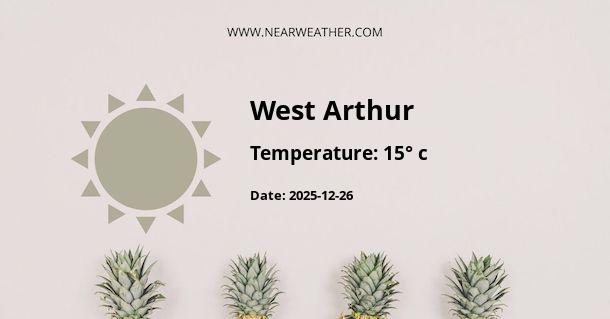West Arthur, Australia: Climate and Weather Overview
West Arthur is a beautiful rural locality located in Western Australia. Known for its stunning landscapes and agricultural activities, the region experiences a unique climate that significantly impacts the local way of life and the area's ecosystem. Understanding the weather patterns and climate of West Arthur is crucial for residents, tourists, and anyone interested in the region. In this comprehensive guide, we will delve into the yearly weather fluctuations, seasonal variations, and climatic characteristics of West Arthur, Australia.
Location and Geographical Influences
Located in Western Australia, West Arthur is positioned in a geographical area that heavily influences its climate. The region experiences a Mediterranean climate, characterized by warm to hot, dry summers and mild, wet winters. The surrounding topography, including the presence of the Indian Ocean to the west, plays a significant role in shaping West Arthur's weather patterns.
Year-Round Climate
Understanding the year-round climate of West Arthur is essential for gaining insight into the region's weather patterns. The table below provides a comprehensive overview of the average monthly temperature and precipitation throughout the year.
| Month | Average Temperature (°C) | Precipitation (mm) |
|---|---|---|
| January | 29 | 12 |
| February | 29 | 11 |
| March | 27 | 20 |
| April | 24 | 48 |
| May | 20 | 87 |
| June | 17 | 130 |
| July | 16 | 139 |
| August | 17 | 107 |
| September | 19 | 80 |
| October | 22 | 48 |
| November | 25 | 27 |
| December | 28 | 16 |
From the data, it is evident that West Arthur experiences a considerable variation in temperature and precipitation throughout the year. Summers are generally hot and dry, while winters are milder and wetter, showcasing the region’s Mediterranean climate characteristics.
Seasonal Variations
The seasonal variations in West Arthur play a significant role in shaping the activities and livelihoods of the local community. Let's explore the distinct characteristics of each season in the region:
Summer (December - February)
- Summer in West Arthur brings hot and dry weather conditions, with average temperatures reaching around 29°C in January and February.
- Low precipitation levels, averaging around 12-16mm per month, contribute to arid conditions during this period.
- The prolonged daylight hours provide ample sunshine for agricultural activities and outdoor pursuits.
Autumn (March - May)
- Autumn sees a gradual decrease in temperature, with average highs ranging from 27°C in March to 20°C in May.
- Precipitation levels begin to increase, with the region receiving between 20-87mm of rain per month during this season.
- The transition from summer to autumn marks a crucial period for agricultural activities, including harvesting and preparation for the upcoming winter.
Winter (June - August)
- Winter brings mild temperatures to West Arthur, with average highs of around 16-17°C during the coldest months of June and July.
- The region experiences higher precipitation levels, with rainfall averaging between 107-139mm per month, contributing to the replenishment of water sources and agricultural lands.
- Cooler weather during this season allows for a brief respite from the intense heat, impacting outdoor activities and agricultural practices.
Spring (September - November)
- Spring marks the transition to warmer temperatures, with average highs ranging from 19°C in September to 25°C in November.
- Precipitation levels diminish compared to winter but remain sufficient for sustaining agricultural activities, with rainfall averaging between 27-80mm per month.
- The onset of spring signals the renewal of vegetation and agricultural growth, making it a pivotal period for the region’s natural landscape and economy.
Climatic Characteristics and Impact on Activities
The unique climatic characteristics of West Arthur significantly influence various activities and industries in the region. The agricultural sector, including wheat farming, livestock rearing, and viticulture, heavily relies on the seasonal variations and precipitation patterns for successful yields. Additionally, the tourism industry benefits from the diverse climate, offering visitors an opportunity to explore the region's natural beauty throughout the year.
The graph below illustrates the average monthly rainfall in West Arthur throughout the year, providing a visual representation of the precipitation patterns:

Source: West Arthur Meteorological Department
Conclusion
As evidenced by the comprehensive analysis of West Arthur's climate and weather patterns, it is clear that the region experiences a Mediterranean climate with distinct seasonal variations. From scorching summers to mild, wet winters, the climate of West Arthur is a defining factor for its agricultural practices, natural landscapes, and overall way of life. By understanding and appreciating the nuances of its climate, residents and visitors can make the most of all that West Arthur has to offer throughout the year.
A - West Arthur's Latitude is -33.440571 & Longitude is 116.685966.
A - Weather in West Arthur is 20° today.
A - Climate Conditions in West Arthur shows scattered clouds today.
A - Humidity in West Arthur is 44% today.
A - Wind speed in West Arthur is 12.17 km/h, flowing at 170° wind direction. today.
